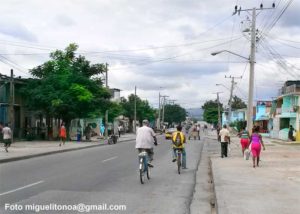From the bustling street of the Trocha de Santiago de Cuba we speak. Its origin seems to go back to the years of the construction of the Battery of Punta Blanca, in 1845, erected in the land ceded by Don Agustín de la Torre.
It is believed that the need to communicate by land with the Castillo del Morro in the eastern Cuban city, forced to draw a trail or trail between the Battery and the old road of the Morro, the current road.
Already designed, bohíos began to appear on both sides with their respective conucos of bananas, cassava, sweet potatoes and other fruits and vegetables. Over time, the proliferation of huts forced its urbanization and from simple gauge turned into street, to the end of receiving different names, according to each stretch of his long journey. This was called Paseo de la Ronda, in the southern part and Paseo de la Circunvalación to the east.
Dancing in La Trocha.
The later story is known. The name of Trocha has kept it by tradition, nevertheless, to have officially received the patriotic denomination of Avenida 24 de Febrero. Of those who cross it “trampling” during Carnival, few know that it was not a joyful estate of comparsas and walks until the 40’s of the last century, when when receiving pavement, attracted the attention that until then had had El Tivolí.
El Tivolí, a neighborhood of the city that melts in itself the cultural syncretisms and ethnic exchanges of Cuban nationality. It had an urbanistic impulse to the heat of the Haitian Revolution in the late eighteenth and early nineteenth centuries. It belongs to the French memory in this south-eastern city.
Trocha has become the carnival street par excellence, so that in other cities baptized with its name those streets, squares and walks more appropriate to the Carnival. Before the 1940s, Trocha was nothing more than a broad dusty avenue in times of drought and muddy rain, adorned with leafy saunas from one end to the other of its long trajectory.
Santiago de Cuba, la histórica calle de “La Trocha”.
De la bulliciosa calle de la Trocha de Santiago de Cuba hablamos. Su origen parece remontarse a los años de la edificación de la Batería de Punta Blanca, en 1845, erigida en los terrenos cedidos por Don Agustín de la Torre.
Créese que la necesidad de comunicarse por tierra con el Castillo del Morro en la ciudad oriental cubana, obligó a trazar una trocha o trillo entre la Batería y el viejo camino del Morro, la actual carretera.
Ya diseñado, comenzaron a aparecer a ambos lados bohíos con sus respectivos conucos de plátanos, yuca, boniatos y otras viandas y frutas. Con el tiempo, la proliferación de chozas obligó a su urbanización y de simple trocha se convirtió en calle, al extremo de recibir distintos nombres, según cada tramo de su largo trayecto. Así se llamó Paseo de la Ronda, en la parte sur y Paseo de la Circunvalación a la parte este.
Arrollar en La Trocha.
La historia posterior es conocida. El nombre de Trocha lo ha conservado por tradición, no obstante, haber recibido oficialmente la patriótica denominación de Avenida 24 de Febrero. De quienes la cruzan “arrollando” durante el Carnaval, pocos saben que no fue un alegre predio de comparsas y paseos hasta los años 40 del pasado siglo, cuando al recibir pavimento, atrajo la atención que hasta entonces había tenido El Tivolí.
El Tivolí, una barriada de la ciudad que funde en sí misma los sincretismos culturales e intercambios étnicos de la nacionalidad cubana. Tuvo un impulso urbanístico al calor de la Revolución Haitiana a finales del siglo XVIII y principios del XIX. Pertenece a la memoria francesa en esta urbe sur oriental.
Trocha ha llegado a ser la calle carnavalesca por antonomasia, de modo tal que en otras ciudades bautizaron con su nombre aquellas calles, plazas y paseos más apropiados al Carnaval. Antes de la década del 40 del siglo XX, Trocha no era más que una amplia avenida polvorienta en los tiempos de sequía y fangosa en épocas de lluvia, adornada de frondosas salvaderas de un extremo a otro de su larga trayectoria.
Agencies/Encyclopedia/Juan Blas Rodríguez/Internet Photos/ Arnoldo Varona/ TheCubanHistory.com
THE CUBAN HISTORY, HOLLYWOOD.









